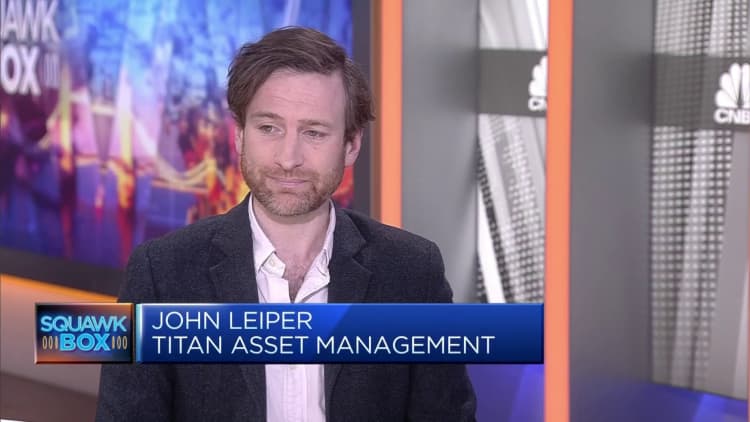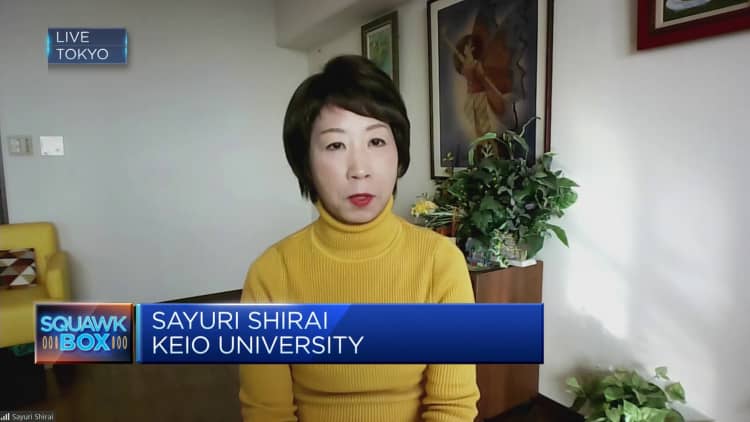A trader works, as a screen displays a news conference by Federal Reserve Board Chairman Jerome Powell following the Fed rate announcement, on the floor of the New York Stock Exchange (NYSE) in New York City, U.S., January 31, 2024.
Brendan McDermid | Reuters
The Bank of Japan and the Swiss National Bank have emerged as the two major central banks most likely to change course in the next two months, according to analysts, but in very different directions.
The U.S. Federal Reserve is expected to cut for the first time in June, with markets narrowly pricing a 25 basis point reduction to take the Fed funds target rate to a range of 5% to 5.25%, according to CME Group’s FedWatch tool.
Minutes from the Fed’s January meeting showed officials were wary of cutting interest rates too quickly, while expressing cautious optimism about the general downward trend on inflation.
The European Central Bank is also projected to start cutting in June, with euro zone inflation easing to 2.8% in January while economic growth remains stagnant across much of the bloc.
The Bank of England is now expected to be among the last to begin unwinding its tight monetary policy, with a slim majority of economists projecting a first cut in August, according to a recent Reuters poll.
Goldman Sachs last week pushed back its projections for rate cuts from May to June, citing several key inflation indicators that look “on the firmer side.”
However, the Wall Street giant suggested the Monetary Policy Committee will then deliver five 25 basis point cuts this year, compared to a market consensus of three, taking the main Bank rate to 4% by December.
On the basis of market expectations, the first G10 central bank to cut rates will be the Swiss National Bank. The market is pricing around a 60% chance of a first 25 basis point cut in March, according to LSEG data, taking the SNB’s key rate down to 1.5%.

Swiss headline inflation fell from 1.7% in December to 1.3% in January, well below consensus forecasts, while core inflation dropped from 1.5% to 1.2%.
Analysts at Capital Economics said the steep decline meant inflation “looks sure to undershoot the SNB’s Q1 forecast of 1.8%.”
“Along with the fall in core inflation, we think this will encourage policymakers at the SNB to cut the policy rate from 1.75% to 1.50% at their next meeting in March,” they added.
Yet the jury is still out ahead of the March 21 meeting, and economists at UBS still believe the SNB will start cutting rates in June, followed by two more cuts in September and December for an eventual terminal rate of 1%.
“We think the SNB will want to wait to ensure that domestic price pressures stemming from higher rents no longer pose upside risks to inflation (its latest forecast assumes inflation picks up to 2% in Q2),” Switzerland’s largest bank said in a note last week.
“However, with the January inflation downside surprise, the SNB forecast looks too high to us, and the probability of a policy rate cut on 21 March has increased. To cut rates, we believe the end-point of the SNB’s inflation forecast would need to decline below 1.5% from currently 1.6%, and the forecast path would have to become downward-sloping.”
Bank of Japan to end negative rate era
While most major central banks are looking at loosening monetary policy after more than two years of aggressive tightening to combat rampant inflation, the question for the Bank of Japan is the opposite.
In a research note Tuesday, Société Générale said the Bank of Japan has everything it needs to finally do away with its negative interest rate and yield curve control policies.
The BOJ’s short-term deposit rate has been set at -0.1% since January 2016, as policymakers looked to stimulate the economy out of a prolonged stagnation. A rate hike would be Japan’s first in 16 years.
The country’s core inflation rate — which excludes food and energy — fell to 2% year-on-year in January, after a third monthly increase, surprising slightly to the upside and suggesting that a sustainable return to ultra-low inflation may not be in the cards.
“If inflation is going to settle around 2%, rather than fall all the way back to the 10-year average (just over 1%), there is no reason to delay the demise of negative interest rate and yield curve control policies,” said Kit Juckes, the French bank’s global head of foreign exchange strategy.

A significant majority of analysts expect the BOJ to end its eight-year stretch of negative interest rates in April, along with its yield curve control policy.
The central bank last July introduced flexibility to its YCC policy, a long-term measure in which it targets a particular interest rate and subsequently buys and sells bonds accordingly to keep the yield on government bonds within that chosen target range.
Frédérique Carrier, head of investment strategy in the British Isles and Asia at RBC Wealth Management, said in a note Friday that the BOJ has been reluctant to tame above-target inflation by ending its negative interest rate policy due to fear of knocking Japan’s already subdued economy further off course.
“Yet, maintaining a loose monetary policy is markedly weakening the yen, contributing to inflation. Inflation above the two percent target for close to two years, as is the case in Japan, would have spurred most western central banks into a tightening cycle, but the BoJ is moving very carefully,” Carrier said.
“Memories of tenacious deflation are still fresh, and consumption is brittle, given Japan’s mature population (average 49 years old vs. 39 in the U.S.). Hiking rates too quickly could risk crashing the economy.”
However, the weak yen has provided a boon for exporters and a headache for importers, and is fueling inflation in Japan, Carrier noted, arguing that the market pricing for a 10 basis point hike by June and 25 basis points by year-end is cautious enough not to puncture the economy.
“And with other central banks cutting rates this year, the interest rate differential with Japan will diminish, in our opinion, alleviating the pressure on the yen,” he added.

